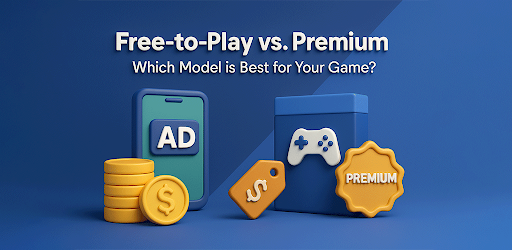The gaming industry offers multiple monetization models, but the two most popular are Free-to-Play (F2P) and Premium (Paid). Choosing the right model can significantly impact your game’s success, revenue, and player engagement.
In this blog, we’ll compare F2P and Premium models, discuss their pros and cons, and help you decide which one suits your game best.
1. Free-to-Play (F2P) Model
Free-to-Play games are downloadable and playable at no initial cost. Revenue is generated through in-game purchases, ads, and microtransactions.
Pros of F2P:
✅ Wider Audience Reach – No upfront cost means more players can try your game.
✅ Higher Player Base – Easier to attract and retain users due to accessibility.
✅ Recurring Revenue – In-app purchases (IAPs), ads, and battle passes create continuous income.
✅ Better for Multiplayer & Live Service Games – Encourages long-term engagement with updates and events.
Cons of F2P:
❌ Monetization Challenges – Balancing fairness vs. profitability can be tricky (avoiding "pay-to-win" criticism).
❌ Higher Development & Marketing Costs – Requires constant updates, server maintenance, and user acquisition spending.
❌ Player Retention Issues – Many users may churn if monetization feels too aggressive.
Best for: Mobile games, live-service titles, multiplayer games, and casual experiences (e.g., Fortnite, Genshin Impact, Candy Crush).
2. Premium (Paid) Model
Premium games require an upfront purchase price before players can access the content.
Pros of Premium:
✅ Predictable Revenue – Immediate income from sales, especially with strong marketing.
✅ Higher Per-Player Value – Players who buy are more invested in the experience.
✅ No Monetization Pressure – No need to design around microtransactions or ads.
✅ Stronger Brand Perception – Often seen as higher quality (e.g., Elden Ring, The Witcher 3).
Cons of Premium:
❌ Smaller Player Base – Higher barrier to entry limits initial downloads.
❌ Piracy Risks – Paid games are more likely to be pirated.
❌ Less Recurring Revenue – Unless offering DLCs or expansions, income may drop post-launch.
Best for: AAA titles, story-driven games, indie passion projects, and single-player experiences.
Which Model Should You Choose?
Go Free-to-Play If:
Your game thrives on a large, engaged community.
You can sustain long-term updates and live services.
Monetization through cosmetics, ads, or season passes makes sense.
Go Premium If:
Your game offers a complete, high-quality experience upfront.
You’re targeting a niche but dedicated audience.
You want to avoid microtransaction controversies.
Hybrid Option: Premium with In-Game Purchases
Some games (e.g., Call of Duty, Destiny 2) combine a base price with optional DLCs or cosmetics, blending both models.
Final Thoughts
There’s no one-size-fits-all answer—your choice depends on your game type, audience, and business goals.
F2P maximizes reach and long-term revenue but requires careful monetization.
Premium ensures immediate profits but limits initial player count.
Analyze your game’s strengths, target market, and monetization potential before deciding!





0 Comments